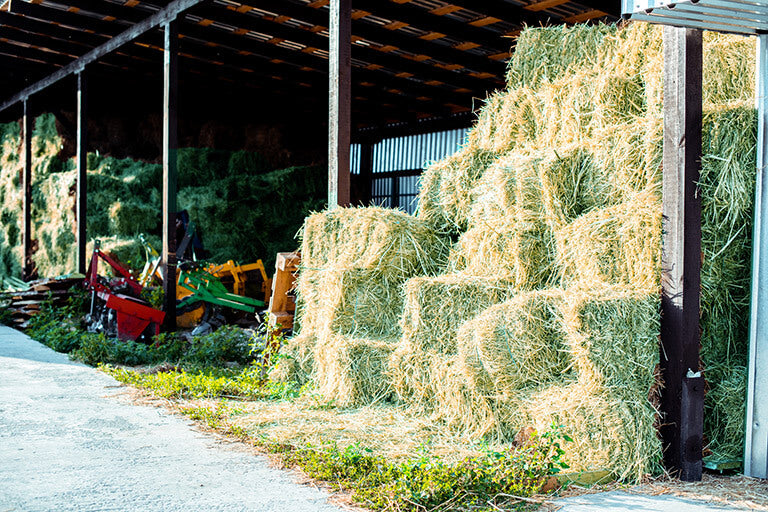We have the lowest delivery fees

How Long Is Hay Good For?
If you are getting ready for a colder season or simply want to stock up on hay for horses, you should know how long it will last. Different horses have different nutritional needs, so you might have to buy various types of hay to optimize their diets. To make sure that the hay you bought lasts you a long while, you need to ensure proper storage conditions. If you provide those, then you can start buying more than a few weeks’ worth at a time. Do you want to know how long is hay good for? Let’s find that out.

Is Your Hay Still Good to Use?
Hay storage is not a concern if you are buying it only for a few weeks at a time. In that case, you can just cover it with a tarp. When you want to store hay over several months, however, it needs more consideration to prevent spoilage. The good news is that if you manage your stores properly, your bales can last almost indefinitely. Storing them in a barn is the best option because it works as a shelter from bad weather, animals, and other conditions. This does not always apply to climates with higher levels of humidity. In those, bales are easier to spoil. That is why in humid climates, it is best to use them within three years since harvest time. To know how long your hay is good for, it can be helpful to make harvest dates visible on bags with feed or record it in some other way.
Factors to Keep in Mind
Moisture is an important factor that affects storage. When buying it, you need to check it thoroughly for quality and moisture. If the hay was bailed with high levels of moisture, this means that mold can develop. Thus, it will spoil much faster. Apart from that, storage conditions impact moisture as well. If you decided to keep your bales in a barn, place them over old hay or straw so that they do not sweat or absorb moisture from other surfaces. Keep your bales in a dry space where moisture or direct sunlight will not reach it.
If hay develops too much moisture, this can lead to mold growing in it. When this happens, feeding horses with such hay can become dangerous. If horses eat moldy hay, they can develop breathing or digestive problems. Moreover, for the horse owners themselves, moldy hay is toxic. It is known to cause “farmer’s lung,” a condition in which farmers inhale fungus, which then grows in the lungs. That is why check your hay storage often, and if you discover mold, it is best to discard the bales as soon as possible.

Losses During Storage
One concern about storing hay for a long time is its nutritional value. The longer it stays in a barn, the more nutrition it loses. In fact, after just a few months, the losses will start, and within a year it could lose 5% of its value. This includes protein, fiber, vitamins, sugars, and minerals. From there, hay does not lose nutrition that much. So if you consider the protein and energy content of hay, which is two years old, it will be similar to the one which is eight months old, for instance.
A more significant nutritional loss in hay is beta-carotene, which is being lost at the rate of about 10% every month, especially if there is exposure to direct sunlight. There is even a chance to have beta-carotene losses during cutting and baling of grass or legume hay. So, if you store your bales for a year or more, then your horses will not be getting this vitamin, which is why you might have to consider adding a supplement to their diets. Why is beta-carotene essential for horses? It plays a significant role in healing processes, cell growth, and healthy vision.
Hay that stays too long in your barn will also lose some of its appeals, in a sense that it might not have the sweet smell of fresh hay any longer. However, you should not worry about the smell as much as the loss of nutrition. If the feed starts developing a musty smell, this means that it soaked up moisture if the storage area is not well-ventilated. Your stored hay might develop mold, especially if you live in a colder climate where you close your barn in the winter season.

Storing Bales of Hay Outside
If you store your bales outdoors, there might be different losses, depending on an array of factors such as moisture at baling, weather during the storage, type of hay, space between bales, and soil quality. May species will lose their dry matter by up to 15% until feeding. Combined with the loss of nutritional value, the losses can add up to as much as 25%. When you buy high-quality feed, this loss is too great to keep it outside. Instead, move it to your barn for storage.
When you choose to store bales outside regardless, make sure to arrange a proper area made up of crushed stones to protect the bottom parts. To reduce losses, ensure that the storage area is well-drained. Also, keep at least 3 feet distance between bale rows for good air circulation. If you have more space, then spread them out even further apart. And if you store bales next to each other, there should be at least 24 inches between them.
Do not place bales in areas of shade or next to trees for storage. The area has to be open for air to circulate better. If you have space inside, move some bales into the barn. Then, there is more room outside, and the feed is protected. This is helpful to do if you have high-quality bales that you will use close to the end of the feeding period, as those will be better protected from weather and other factors indoors.


Leave a comment